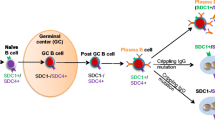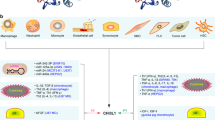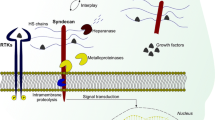Abstract
Syndecans are transmembrane proteoglycans, with core proteins mainly decorated with heparan sulfate chains. Syndecan-1 is expressed in a tissue-, cell-and differentiation-specific manner. Its extra-cellular domain can bind via HS chains to matrix elements, to growth factors (especially “heparin-binding” proteins) and to certain biological agents. The ectodomain released by proteolysis can also be functionally active. The cytoplasmic domain can take part in signaling processes as well as in modifying cell shape. In hematopoietic cells syndecan-1 is expressed in normal pre-B-cells and plasma cells, as well as in plasmocytoid and lymphoplasmocytoid malignancies. According to our study syndecan-1 is expressed in B-CLL cells both in tissue environment and in circulation.
Similar content being viewed by others
References
Gallagher JT: The extended family of proteoglycans: social res- idens of the pericellular zone. Current Opinion Cell Biol 1:1201–1218, 1989.
Barry F: Genetic and structural organization of proteoglycans. Biochemistry 18:197–198, 1990.
Kjellén L, Lindahl U: Proteoglycans: structures and interactions. Annu Rev Biochem 60:443–475, 1991.
Iozzo RV: Biology of Diseases Proteoglycans: structure, and role in neoplasia. Lab Invest 53:373–390, 1985.
Rouslahti E, Yamaguchi Y: Proteoglycans as modulators of growth factors activities. Cell 84:867–869, 1991.
Fransson LA: Structure and function of cell associated proteoglycans. TIBS 12:406–412, 1987.
Hardingham TE, Fosang AJ: Proteoglycans: many forms and many functions. FASEB J 6:861–870, 1992.
David G: Integral membrane heparan sulfate proteoglycans. FASEB J 7:1023–1030, 1993.
Iozzo R, Murdoch AD: Proteoglycans of the extracellular envi- ronment: clues for gene and protein side offer novel perspec- tives in molecular diversity and function. FASEB J 10:598–614, 1996.
Salmivirta M, Lidholt K, Lindahl U: Heparan sulfate: a piece of information. FASEB J 10: 1270–1279, 1996.
Bernfield M, Kökényesi R, Kato M, et al: Biology of the syndecans: a family of four transmembrane heparan sulfate proteoglycans. Annu Rev Cell Biol 8:365–393, 1992.
Yanagishita M, Hascall VC: Cell surface heparan sulfate pro- teoglycans. J Biol Chem 1992. 267:9451–9454, 1992.
Rapraeger AC: The coordinated regulation of heparan sulfate, syndecans and cell behaviour. Curr Opin Cell Biol 5:844–853, 1993.
Salmivirta M, Jalkanen M: Syndecan family of cell surface proteoglycans: developmentally regulated receptors for extracellular effector molecules. Experientia 51:863–872, 1995.
Kim CW, Goldberger OA, Gallo RL, Bernfield M: Members of the syndecan family of heparan sulfate proteoglycans are expressed in distinct cell-, tissue-, and development-specific patterns. Mol Biol Cell 5:797–805, 1994.
Bernfield M, Hinkess MT, Gallo RL: Developmental expression of the syndecans: possible function and regulation. Dev Suppl 205–212, 1993.
Bartold PM, Moule AJ, Li H, Rigby P: Isolation and characteri- zation of the proteoglycans synthesized by adult human pulp fibroblasts in vitro. Int Endod J 28:163–171, 1995.
Kainulainen V, Nelimarkka L, Jarvelainen H, et al: Suppression of syndecan-1 expression in endothelial cells by tumor necrosis factor-alpha. J Biol Chem 271: 18759–18766, 1996.
Weiner OH, Zorembe M, Gressner AM: Gene expression of syndecans and betaglycan in isolated rat liver cells. Cell Tissue Res 285: 11–16, 1996.
Kovalszky I, Gallai M, Armbrust T, Ramadori G: Syndecan-1 gene expression in isolated rat liver cells (hepatocytes, Kuppfer cells, endothelial and Ito cells). Biochem Biophys Res Commun 204:944–949, 1994.
Chernousov MA, Stahl RC, Carey DJ: Schwann cells secrete a novel collagen-like adhesive protein that binds syndecan. J Biol Chem 271:13844–13853, 1996.
Carey DJ, Stahl RC, Cizmeci-Smith G, Asundi VK: Syndecan-1 expressed in Schwann cells causes morphological transformation and cytoskeletal reorganization and associates with actin during cell spreading. J Cell Biol 124:161–170, 1994.
Lories V, Cassiman JJ, Van den Berghe H, David G: Differential expression of cell surface heparan sulfate proteoglycans in human mammary epithelial cells and lung fibroblasts. J Biol Chem 267: 1116–1122, 1992.
Salmivirta M, Rauvala H, Elenius K, Jalkanen M: Neurite growth-promoting protein (amphotherin, p30) binds syndecan. Exp Cell Res 200:444–451, 1992.
Piepkorn M, Hoving P, Linker A: Topography of proteoglycans and glycosaminoglycan free chain expression in 3T3 fibroblasts and human keratinocytes. J Invest Dermatol 99:386–389, 1992.
Engeelmann S, Ebeling O, Schwartz-Albiez R: Modulated glycolisation of proteoglycans during differentiation of human B lymphocytes. Biochem Biophys Acta 1267:6–14, 1995.
Saunders S, Jalkanen M, O’Farell S, Bernfield M: Molecular cloning of syndecan, an integral membrane proteoglycan. J Cell Biol 108:1547–1556, 1989.
Mali M, Jaakkola P, Arvilommi AM, Jalkanen M: Sequence of human syndecan indicates a novel gene family of integral membrane proteoglycans. J Biol Chem 265:6884–6889, 1990.
Kojima T, Shworak NW, Rosenberg RD: Molecular cloning and expression of two distinct cDNA-encoding heparan sulfate proteoglycan core proteins from rat endothelial cells. J Biol Chem 267:4870–4877, 1992.
Kiefer M, Stephens J, Crawford J, et al: Ligand affinity cloning and structure of cell surface proteoglycans that binds basic fibroblast growth factor. Proc Natl Acad Sci 87:6985–6989, 1990.
Vihinen T, Auvinen P, Alanen-Kurki L, Jalkanen M: Structural organization and genomic sequence of mouse syndecan-1 gene. J Biol Chem 268:7261–7269, 1993.
Spring J, Goldberger OA, Jenkins NA, et al: Mapping of the syndecan genes in the mouse: linkage with members of the myc gene family. Genomics 21:597–601, 1994.
Kaukonen J, Alanen-Kurki L, Jalkanen M, Palotie M: The mapping and visual ordering of the human syndecan-1 and N-myc genes near the telomeric region of chromosome 2p. Hum Genet 99:295–297, 1997.
George RE, Kenyon RM, McGuckin AG, et al: Investigation of co-amplification of the candidate genes ornithin decarboxylase, ribonucleotide reductase, syndecan-1 and DEAD box gene, DDX1 with N-myc in neuroblastoma. Oncogene 12:1583–1587, 1996.
Kapee M, Nevanlinna H, Mali M, et al: Localization of gene for human syndecan, an integral membrane proteoglycan and matrix receptor, to chromosome 2. Somat Cell Mol Genet 16:501–505, 1990.
Oettinger HF, Streeter H, Lose E, et al: Chromosome mapping of the murine syndecan gene. Genomics 11:334–338, 1991.
Vihinen T, Maatta A, Jaakkola P, et al: Functional characteriza- tion of mouse syndecan-1 promoter. J Biol Chem 271:12532–15541, 1996.
Rinkes MT, Goldberger OA, Neumann PE, et al: Organization and promoter activity of the mouse syndecan-1 gene. J Biol Chem 268:11440–11448, 1993.
Kökényesi R, Bernfield M: Core protein structure and sequence determine the site and presence of heparan sulfate and chon- droitin sulfate on syndecan-1. J Biol Chem 269:12304–12309, 1994.
Kato M, Wang H, Bernfield M, et al: Cell surface syndecan-1 on distinct cell types differs in fine structure and ligand binding of its heparan sulfate chains. J Biol Chem 269:18881–18890, 1994.
Bernfield M, Sanderson RD: Syndecan, a developmentally regulated cell surface proteoglycan that binds extracellular matrix and growth factors. Phylos Trans R Soc Lond B Biol Sci 327:171–186, 1990.
Boutin EL, Sanderson RD, Bernfield M, Cunha GR: Epithelial-mesenchymal interactions in uterus and vagina alter the expression of the cell surface proteoglycan, syndecan. Dev Biol 148:63–74, 1991.
Brauker JH, Trautman MS, Bernfield M: Syndecan, a cell sur- face proteoglycan, exhibits a molecular polymorphism during lung development. Dev Biol 147:285–292, 1991.
Sanderson RD, Hinkes MT, Bernfield M: Syndecan-1, a cell-sur- face proteoglycan, changes in size and abundance when keratinocytes stratify. J Invest Dermatol 99:390–396, 1992.
Sanderson RD, Sneed TB, Yuong LA, et al: Adhesion of B lymphoid (MPC-11) cells to type I collagen is mediated by integral membrane proteoglycans, syndecan. J Immunol 148:3902–3911, 1992.
Sanderson RD, Bernfield M: Molecular polymorphism of cell surface proteoglycan: distinct structures on simple and stratified epithelia. Proc Natl Acad Sci USA 85:9562–9566, 1988.
Kato M, Bernfield M: Polymorphism of syndecan. A distinctive form on mesenchymal cells. J Cell Biol 109:320a, 1989.
Salmivirta M, Elenius K, Vainio S, et al: Syndecan from embryonic tooth mesenchyme binds tenascin. J Biol Chem 266:7773–7739, 1991.
Saunders S, Bernfield M: Cell surface proteoglycan binds mouse mammary epithelial cells to fibronectin and behaves as a receptor for interstitial matrix. J Cell Biol 106:423–430, 1988.
Ihrcke NS, Platt JL: Shedding of heparan sulfate proteoglycan by stimulated endothelial cells: evidence for proteolysis of cell surface molecules. J Cell Physiol 168:625–637, 1996.
Zeamen C, Rapraeger AC: Post-transcriptional regulation of syndecan-1 expression by cAMP in peritoneal macrophages. J Cell Biol 122:941–950, 1993.
Ruohola JK, Valve EM, Vainikka S, et al: Androgen and fibroblast growth factor (FGF) regulation of FGF receptors in S115 mouse mammary tumor cells. Endocrinology 136:2179–2188, 1995.
Leppa S, Harkonen P, Jalkanen M: Steroid- induced epithelial-fibroblastic conversion associated with syndecan suppression in S115 mouse mammary tumor cells. Cell Regul 2:1–11, 1991.
Romans M, Bassols A, David G: Effect of transforming growth factor-beta 1 and basic fibroblast growth factor on the expression of cell surface proteoglycans in human lung fibroblasts. Enhanced glycanation and fibronectin-binding of CD44 proteoglycan and downregulation of glypican. BioChem J 310:73–81, 1995.
Elenius K, Maatta A, Salmivirta M, Jalkanen M: Growth factors induce 3T3 cells to express bFGF-binding syndecan. J Biol Chem 267:6435–41, 1992.
Sutherland AE, Sanderson RD, Mayes M, et al: Expression of syndecan, a putative low affinity fibroblast growth factor receptor, in the early mouse embryo. Development 113:339–351, 1991.
Vainio S, Thesleff I: Coordinated induction of cell proliferation and syndecan expression in dental mesenchyme by epithelium: evidence for diffusible signals. Dev Dyn 194:105–117, 1992.
Saxen L, Thesleff I: Epithelial- mesenchymal interactions in murine organogenesis.Ciba Found Symp 165:183–193, 1992.
Bucci P, Canfora M, Cocozza G, et al: The role of syndecan and tenascin during tooth development. Minerva Stomatol 45:259–266, 1996.
Thesslef I, Vaahtokari A, Vainio S, Jowett A: Molecular mechanism of cell and tissue interactions during early tooth development. Anat Rec 245:151–161, 1996.
Vainio S, Jalkanen M, Bernfield M, Saxen L: Transient expression of syndecan in mesenchymal cell aggregates of the embryonic kidney. Dev Biol 152:221–232, 1992.
Vainio S, Lehtonen E, Jalkanen M, et al: Epithelial-mesenchymal interactions regulate the stage specific expression of a cell surface proteoglycan, syndecan, in the developing kidney. Dev Biol 134:382–391, 1989.
Tarutmann MS, Kielman J, Bernfield M: Developmental expression of syndecan, an integral membrane proteoglycan, correlates with cell differentiation. Development 111:213–220, 1991.
Cizmeci-Smith G, Athal RC, Showalter LJ, Carey DJ: Differential expression of transmembrane proteoglycans in vascular smooth muscle cells. J Biol Chem 268:18740–18747, 1993.
Sanderson RD, Lalor P, Bernfield M: B lymphocytes express and lose syndecan at specific stages of differentiation. Cell Regul 1:27–35, 1989.
Inki P, Larjava H, Haapasalmi K, et al: Expression of syndecan-1 is induced by differentiation and suppressed by malignant transformation of human keratinocytes. Eur J Cell Biol 63:43–51, 1994.
Inki P, Stenback F, Talve L, Jalkanen M: Immunhistochemical localization of syndecan in mouse skin tumours induced by UV irradiation. Loss of expression associated with malignant transformation. Am J Pathol 139:1333–1340, 1991.
Inki P, Stenback F, Grenman R, Jalkanen M: Immunhistochemical localization of syndecan-1 in normal and pathological human uterine cervix. J Pathol 172:349–355, 1994.
Inki P, Joensuu H, Grenman R, et al: Association between syn- decan-1 expression and clinical outcome in squamous cell car- cinoma of the head and neck. Br J Cancer 70:319–323, 1994.
Levy P, Munier A, Baron-Delage S, et al: Syndecan-1 alterations during the tumorigenic progression of human colonic Caco-2 cells induced by human Ha-ras or polyoma middle T oncogenes. Br J Cancer 74:423–431, 1996.
Kovalszky I, Schaff Zs, Jeney A: Potential markers (enzymes, proteoglycans) for human liver tumors. Acta Biomed Ateno Parmense 64:157–163, 1993.
Jiang R, Kato M, Bernfield M, Grabel LB: Expression of syndecan-1 changes during the differentiation of visceral and parietal endoderm from murine teratocarcinoma cells. Differentiation 59:225–233, 1995.
Sanderson RD, Turnbull JE, Gallagher JT, Lander AD: Fine structure of heparan sulfate regulates syndecan-1 function and cell behaviour. J Biol Chem 269:13100–13106, 1994.
Jalkanen M, Elenius K, Salmivirta M: Syndecan - a cell surface proteoglycan that selectively binds extracellular effector molecules. Adv. Exp. Med Biol. 313:79–85, 1992.
San-Antonio JD, Karnovszky MJ, Gay S, et al: Interactions of syndecan-1 and heparin with human collagens. Glycobiology 4:327–332, 1994.
Corless CL, Mendoza A, Collins T, Lawler J: Colocalization of trombospondin and syndecan during murine development. Dev Dyn 193:346–358, 1992.
Vainio S, Thesleff I: Sequential induction of syndecan, tenascin and cell proliferation associated with mesenchymal cell condensation during early tooth development. Differentiation 50:97–105, 1992.
Thesleff I, Vainio S, Inki P, et al: Syndecan and tenascin: induction during early tooth morphogenesis and possible interactions. Cell Differ Dev 32:17837–17843, 1990.
Salmivirta M, Mali M, Heino J, et al: A novel laminin-binding form of syndecan-1 (cell surface proteoglycan) produced by syndecan-1 cDNA-transfected NIH-3T3 cells. Exp Cell Res 215:180–188, 1994.
Lebakken CS, Rapraeger AC: Syndecan-1 mediates cell spreading in transfected human lymphoblastoid (Raji) cells. J CellBiol 132:1209–1221, 1996.
Liebersbach BF, Sanderson RD: Expression of syndecan-1 inhibits cell invasion intotype I collagen. J Biol Chem 269:20013–20019, 1994.
Ross CR, Kubinak S, Hale CC: Purification of a basic fibroblast growth factor-binding proteoglycan from bovine cardiac plasma membrane. Biochim Biophys Acta 1145:219–229, 1993.
Kiefer MC, Ichihara M, Swiedler SJ, et al: The molecular biol- ogy of heparan sulfate fibroblast growth factor receptor. Ann NY Acad Sci 638:167–176, 1991.
Elenius K, Jalkanen M: Function of the syndecans - a family of cell surface proteoglycans. J Cell Sci 107:2975–2982, 1994.
Mitsiadis TA, Salmivirta M, Muramatsu T, et al: Expression of the heparin-binding cytokines, midkine (MK) and HB-GAM (pleitropin) is associated with epithelial-mesenchymal interac- tions during fetal development and organogenesis, Development 121:37–51, 1995.
Olwin BB, Rapraeger AC: Repression of myogenic differentia- tion by aFGE bFGF and K-FGF is dependent on cellular heparan sulfate. J Cell Biol 118:631–639, 1992.
van Putten JP, Paul SM: Binding of syndecan-like cell surface proteoglycan receptors is required for Neisseria gonorhoae entry into human mucosal cells. EMBO J 14:2144–2154, 1995.
Pervert U, Sinnis P, Cerami C, et al: Malaria circumsporozoite protein binds to heparan sulfate proteoglycans associated the surface membrane of hepatocytes. J Exp Med 177:1287–1298, 1993.
Mali M, Andtfolk H, Miettinen HM, Jalkanen M: Supression of tumor cell growth by syndecan-1 ectodomain. J Biol Chem 269:27795–27798, 1994.
Prasthofer T, Ek B, Ekman P, et al: Protein kinase C phosphory- lates two of the four known syndecan cytoplasmic domains in vitro. 36:793–802, 1995.
Reiland J, Ott VL, Lebakken CS, et al: Pervanadate activataion of intracellular kinases leads to tyrosine phosphorilation and shedding of syndecan-1. Biochem J 319:39–47, 1996.
Carey DJ, Bendt KM, Stahl RC: The cytoplasmic domain of syndecan-1 is required for cytoskeleton association but not detergent insolubility. Identification of essential cytoplasmic domain residues. J Biol Chem 271:15253–15260, 1996.
Carey DJ, Stahl RC, Tucker B, et al: Aggregation-induced asso- ciation of syndecan-1 with microfilaments mediated by the cytoplasmic domain. Exp Cell Res 214.12–21, 1994.
Miettinen HM, Edwards SN, Jalkanen M: Analysis of transport and targeting of syndecan-1: effect of cytoplasmic tail deletions. Mol Biol Cell 5:1325–1339, 1994.
Keating A, Gordon MY: Hierachial organization of hematopoietic microenvironments: role of proteoglycans. Leukemia 2:766–769, 1988.
Gallagher JT, Spoocer E, Dexter TM: Role of the cellular matrix in haemopoiesis. Synthesis of glycosaminoglycans by mouse bone marrow cell cultures. J Cell Sci 63:155–171, 1983.
Wight TN, Kinsella MG, Keating A, Singer JW: Proteoglycans in human long-term bone marrow cultures: biochemical and ultrastructural analyses. Blood 67:1333–1343, 1986.
Keating A, Nguyen C, Aziomamitis A: Effect of glycosamino- glycan on hematopoiesis. Blood 68:1449–1455, 1986.
Roberts R, Gallagher J, Spooncer E, et al: Heparan sulfate bound growth factors: a mechanism for stromal cell mediated haemopoiesis. Nature 332:376–378, 1988.
Del Rosso M, Cappeletti R, Dini G, et al: Involvement of gly- cosaminoglycans in detachmant of early myeloid precursors from bone marrow stromal cells. Biochim Biophys Acta 676:129–136, 1981.
Kinsella MG, Wight TN: Modulation of sulfated proteoglycan sythesis by bovic aortic endothelial cells during migration. J Cell Biol 102:679–687, 1986.
Ihrcke NS, Wrenshall LE, Lindmann BJ, Platt JL: Role of heparan sulfate in immune system-blood vessel interactions. Immunol Today 14:500–504, 1993.
Nelson RM, Cecconi O, Roberts WG, et al: Heparin Oligosaccharides bind L- and P-selectin and inhibit acute inflammation. Blood 82:3253–3258, 1993.
Lalor PA, Nossal GJV, Sanderson RD, McHeyzer-Williams MG: Functional and molecular characterization of single (4-hydroxy-3-nitrophenyl) acetyl (NP)-specific, IgGl-+ B cells from antibodysecreting and memory B cell pathways in the C57BL/6 immune response to NP. Eur J Immunol 22:3001–3011, 1992.
Wijdenes J, Vooijs WC, Clement C, et al: A plasmocyte selective monoclonal antibody (B-B4) recognizes syndecan-1. Br J Haematol 94:318–323, 1996.
Hodgkin PD, Leen JH, Lyons AB: B cell differentiation and iso- type switching is related to division cycle number. J Exp Med 184:277–281, 1996.
Dustin LB, Bullock ED, Hamada Y, et al: Antigen-driven differ- entiationof naive Ig-transgenic B cells in vitro, J Immunol 154:4936–49, 1995.
Smith KGC, Hewitson TD, Nossal GJV, Tarlinton DM: The phenotype and fate of the antibody-forming cells of the splenic foci. Eur J Immunol 26:444–448, 1996.
Turner CA, Mack DH, Davis MM: Blimp-1, a novel Zinc finger containing protein that can drive the maturation of B lymphocytes into immunglobulin-secreting cells. Cell 77:297–306, 1994.
Usui T, Wakatsuki Y, Matsunaga Y, et al: Overexpression of B cell specific activator protein (BSAP/Pax-5) in late cell is sufficient to suppress differentiation to an Ig high producer cell with plasma cell phenotype. J Immunol 158:3197–3204, 1997.
Riedley RC, Xiao H, Hata H, et al: Expression of syndecan regulates human myeloma plasma cell adhesion to type I collagen. Blood 81:767–774, 1993.
Stanley MJ, Liebersbach BE, Liu W, et al: Heparan sulfate-mediated cell aggregation. Syndecan-1 and -4 mediated intercellular adhesion following their transfection into human B lymphoid cells. J Biol Chem 270:5077–5083, 1995.
Sanderson RD, Turnbull JE, Gallagher JT, Lander AD: Fine structure of heparan sulfate regulates syndecan-1 function and cell behaviour. J Biol Chem 269:13000–13106, 1994.
Sebestyén A, Kovalszky I, Gallai M, Bocsi J, László E, Benedek Sz, Sréter L, Kopper L: Expression of syndecan-1 in human B cell chronic lymphocytic leukemia. Europ J Cancer (in press).
Carbone A, Gloghini A, Gattei V, et al: Reed-Sternberg cells of classical Hodgkin’s disease react with the plasma cell-specific monoclonal antibody B-B4 and express human syndecan-1. Blood 89:3787–3794, 1997.
Sneed TB, Stanley DJ, Young LA, Sanderson RD: Interleukin-6 regulates expression of the syndecan-1 proteoglycan on lymphoid cells. Cell Immunol 153:456–467, 1994.
Author information
Authors and Affiliations
Corresponding author
Additional information
This work has been supported by OTKA T107083 project (L. K.)
Rights and permissions
About this article
Cite this article
Kopper, L., SebestyÉn, A., Gallai, M. et al. Syndecan-1 - A new piece in B-cell puzzle. Pathol. Oncol. Res. 3, 183–191 (1997). https://doi.org/10.1007/BF02899919
Received:
Accepted:
Issue Date:
DOI: https://doi.org/10.1007/BF02899919




